Our
Manú story 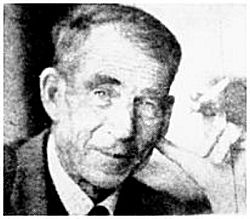 We
were lucky. The years of our wildlife exploration of the high Andes coincided
with those of Major Ian Grimwood who was on an official assignment with the Peruvian
Government to pinpoint wildlife refuge areas in Peru. Ian Grimwood was a specialist
with a track record of protecting wildife in Kenya and saving the Oryx in Arabia. We
were lucky. The years of our wildlife exploration of the high Andes coincided
with those of Major Ian Grimwood who was on an official assignment with the Peruvian
Government to pinpoint wildlife refuge areas in Peru. Ian Grimwood was a specialist
with a track record of protecting wildife in Kenya and saving the Oryx in Arabia.
When
in Lima, the Peruvian capital, we often met in 'Henry's' a coffee place close
the British Embassy. We swapped notes lamenting frequently on the state of the
nation's parks and scarcity of guards. I was on the look out for a film story
in the Peruvian Amazon then on the brink of a 'great opening' with new roads especially
the 'Marginal Highway' [Proyecto Carretera Maginal] being built along the Amazon
fringe of the eastern Andes. Fernando Belaunde Terry, the Peruvian President envisaged
opening up the Amazon lowlands which comprise almost four fifths of the country.
The plan involved colonisation - agriculture - tapping the natural rescources
and improving communications. In
Bolivia we received a letter from Ian which changed our schedule completely and
looking back maybe it changed the course of our life Ian
Grimwood wrote 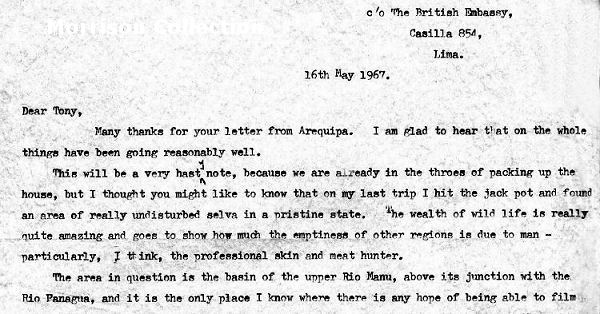
Today
the Manú Park is recognised as one of the world's greatest hotspots for
biodiversity and is a UNESCO World Heriage Site. The range of altitude is extraordinary,
from over 4000m in the Andes mountains, down the eastern slope to seriously massive
forest at about 200m. The Reserve holds thousand of species including 160 mammal
species and reputely 1000 bird species. Ian had hit on a treasure - truly a Naturalist's
El Dorado. Ian
put the idea of protection to the World Wildlife Fund and seed money came in to
establish a guard-post in the lower river. At the same time the Peruvian Government
gave the area 'Reserve Status' hoping to protect against loggers and trappers. We
put the idea to Chris Parsons,then Head of the BBC Natural History Unit in Bristol,
UK and were given the go ahead to make an hour long film for BBC TWO, the BBC's
newly introduced colour channel. [David Attenborough had just been appointed Controller.] Our
plan We set up
a base in Cusco the Peruvian mountain city, and once the centre of the Inca Empire.
We found a room in an old house close to the Plaza de Armas, the principal square.
Ian had given us an introduction to the Kalinowski family and we asked Hugo Echeguray
an old friend from earlier expeditions to help arrrange the river journey- please
remember all this was with heavy gear, no mobile 'phones - no 'phones anywhere
in the forest -and we needed food for a month. We
used our Land Rover to descend the crude mountain road to the upper Madre de Dios
river taking with us an 60 HP Johnson outboard, food, camping and medical supplies.
Hugo arranged for three 44 gallon drums of fuel to be sent down the same road
in a local truck. We
loaded at Shintuya - then a settlemnt of one palm thatched house on the
Alto Madre de Dios River 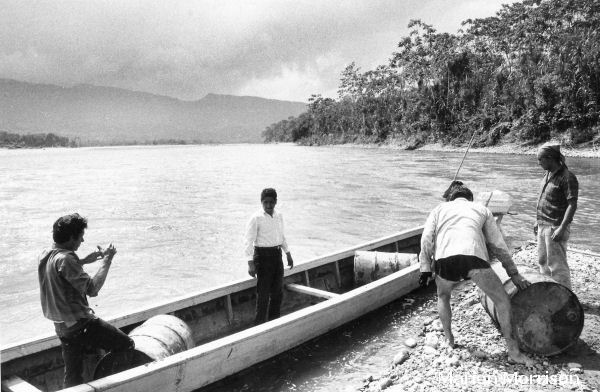
The
large canoe was hired from the Kalinowski family. Hugo on the right was i/c and
the mouth of the Manú a tributary coming in from the left bank was about
a day away beyond the distant Andean foothills. Once
in the Manú river we used the large canoe as far as the World Wildife Fund
guard post where we knew we could borrow a small canoe which I could manage with
help from the guards. We filmed the guards, the local Machiguenga people [now
Ashaninka], and we camped alone on remote beaches. The wildlife was natural, undisturbed
and superb. We ate fish from the river cooked over our fire and on Marion's birthday
we opened a tin of peaches from Chile - a treat. Did
we have any close escapes? Some of the snakes could have been dangerous but we
took care. The most memorable event was when Marion was stung by a swarm of small
bees and we counted more than a hundred bumps. 
We
could not have wished for more though once we had the river story 'in the can'
- it was 16mm film - we took our cameras into the mountains and deep gorges in
the cloud forest to film the Cock of the RocK, a rare bird and for the male, so
vividly coloured. Finding it was like looking for a 'needle in a haystack' - luckily
I had seen one five years earlier in the forests of Vilcabamba beyond Machu Picchu.
I knew the favoured altidude and the local names. 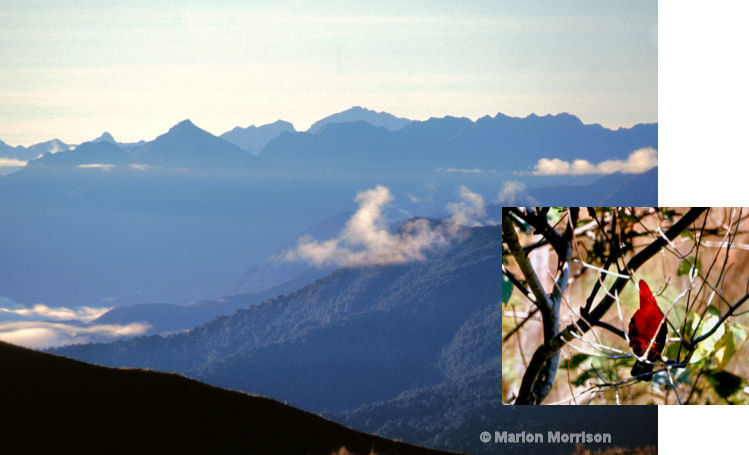
Filming 'Manú' took six months and we had one more assignment to complete
in the Falkland Island [Islas Malvinas] before returning to London. The
Manú story was produced at the Natural History Unit in Bristol by the highly
talented Suzanne Gibbs who gave it just the right touch to make it hit the Press
as A Park
in Peru. 
But
that was not the end of the story A
Park in Peru was chosen for a showing at the World Wildlife Fund Second International
Congress in London in November 1970 and we were asked to add a small exhibition
of photographs. Kodak sponsored some of the colour work while the black and white
prints were made by Robert Horner. More
international television transmissions followed and later in London we presented
the story at charity events including one held at The Tower of London - one of
London's Historic Royal Palaces. And
finally - the WWF Congress led to the Exhibition of photos in the Kodak Window...... 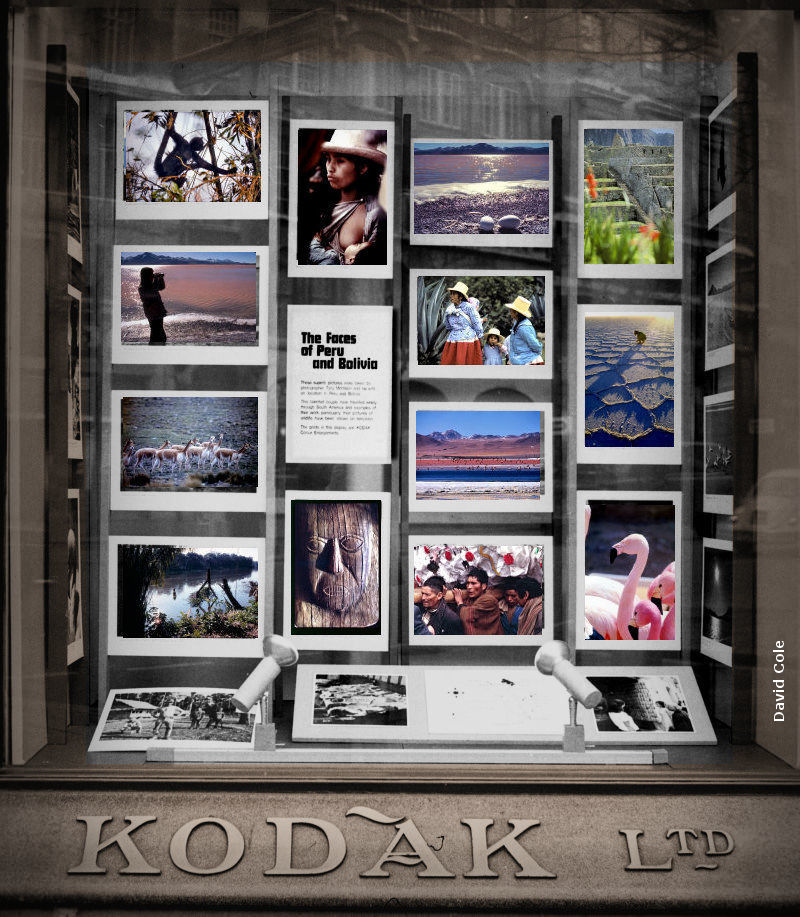
Tech
- We were using Nikon F [SLR] cameras with a range of Nikkor lenses. The exposure
meter was a hand held Weston Master lll. The film stock was either Kodachrome
35mm processed by Kodak London or Kodak Ektachrome 35mm processed by Authenticolour,
London . David's
picture of the window was shot on a British made Microflex TLR camera using black
and white film. The colour was with a computer using scans from the origiinal
Kodak prints. The
pictures in the bottom row of the window were in black and white made by Robert
Horner and a map made by Kodak Update
- The Manú National Park is known throughout the scientific world as a
'gem of nature'. Parts are open to visitors with permits while for most areas
the access is restricted to scientists. I filmed there in 1985 and in 1986 was
taken by helicopter to the remote 'divide' known as the Isthmus of Fitzcarrald
between the Manú flowing southwest and the Sepahua flowing southeast. In
1986 I went to find one of the small groups of forest people who have minimal
contact with the outside world. But in even more distant parts some tribes have
never had contact and are in considerable danger from intruders - often gold panners
and loggers. Road builders and land prospectors are more than on the fringes ready
to take the once tribal land. The Interoceanic Highway built in the early 2000s
to link the Pacific with the Atlantic is branching spur roads with dozens of settlements.
All around is now endangered by changes to the laws that prevent oil /gas exploration.
And we are not yet twenty years into the 2ist Century.
Both Ian Grimwood an Hugo Echegeray died some years ago Tony
Morrison 2018 |